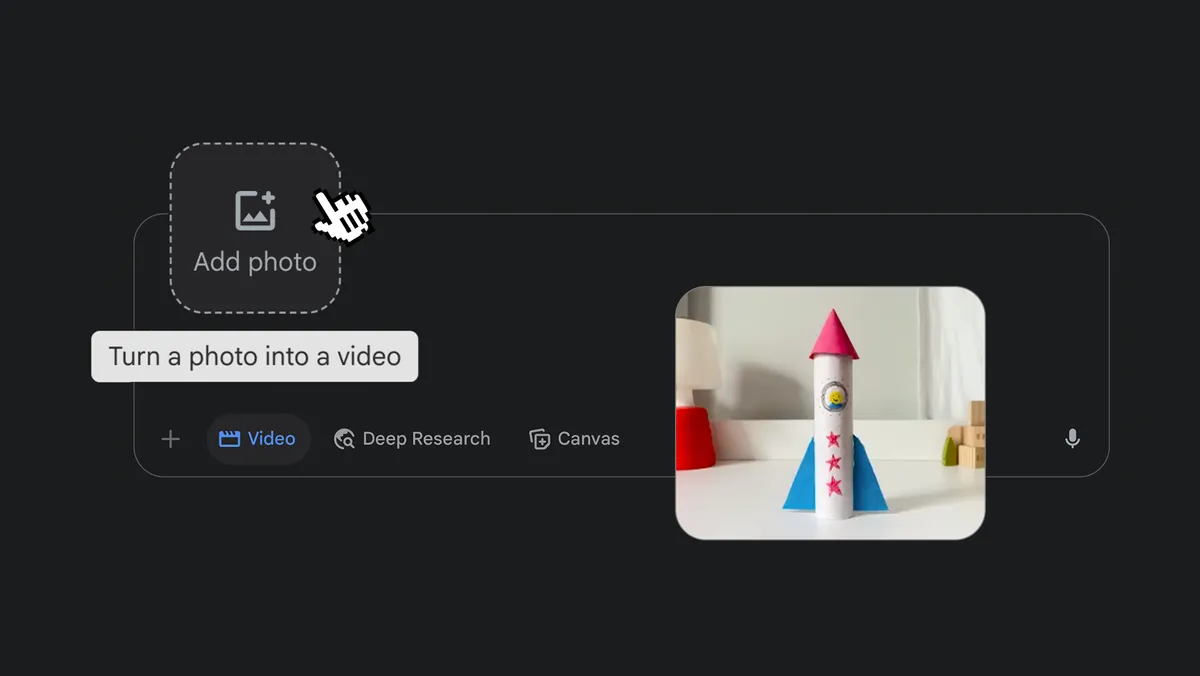New photo‑to‑video feature in Gemini AI powered by Veo 3 offers 8‑second video clips, blending sound and visuals for creative storytelling
Google has rolled out a groundbreaking photo‑to‑video function within its Gemini AI platform, making waves in the world of AI video generation. Announced on July 10, 2025, the feature enables subscribers on the Google AI Pro and Ultra plans in select regions to transform static photos into dynamic 8‑second video clips, complete with synchronized sound—background audio, ambient noise, even dialogue—driven by the advanced Veo 3 model.
Bringing Still Photos Alive with Gemini’s Veo 3
In a detailed blog post, Google’s Gemini team described how users can bring photos to life: choose the “Video” option within the prompt bar, upload an image, and provide a text prompt describing how the scene should move and sound. From animating nature scenes and everyday objects to turning drawings or paintings into short motion clips, imagination is the limit.
Google reports over 40 million Veo 3 videos have been created via Gemini and its companion app Flow in just seven weeks, demonstrating widespread adoption and demand.
Seamless Access for Subscribers
The photo‑to‑video capability launched first via the Gemini web app on July 10, 2025, and will roll out to mobile users by week’s end. Access is exclusive to Pro and Ultra plan subscribers in around 150 countries, with a creation limit of three videos per day and no carry-over of unused quota.
Each generated clip is delivered as a 720p MP4 in 16:9 format and includes a visible “Veo” watermark and an invisible SynthID digital watermark to mark the AI provenance of the content.
Safety, Governance, and Creative Control
Google emphasizes its commitment to responsible AI video generation. The tool underwent extensive “red teaming” to detect misuse risks—Google now applies multi-layer safety testing and strict content policies. Both visible and embedded watermarks support content transparency and traceability, helping users and platforms detect AI-generated media.
However, the rapid evolution of AI video tools also brings concerns: potential for deepfakes, infringement on copyrights, and misinformation remain open challenges for creators, platforms, and regulators alike.
Photo‑to‑Video vs Flow vs Competitors
While Google’s Flow app already offered photo‑to‑video animation, the integration directly into Gemini simplifies the workflow—no need to switch apps. Flow is also expanding to 75 more countries in tandem with the Gemini rollout.
Google’s move comes amid fierce competition: OpenAI’s Sora, Luma Labs’ Dream Machine, and other AI video tools are racing to offer intuitive and high-quality video generation options. Gemini’s advantage lies in its tight integration with Google’s broader AI ecosystem and Gemini chat interface.
What It Means for Creators and Marketers
For marketers, creators, and casual users alike, the ability to animate a single photo into a short video opens up new storytelling formats—from engaging social media clips to personal digital keepsakes. And with minimal effort, users can enhance ordinary content with motion and sound that previously required significant video editing skills.
Still, experts urge users to remain mindful. Technologies like Gemini’s AI video generation might democratize content creation, but they also pose ethical challenges. Professionals and regulators are calling for stronger governance around AI-generated content authenticity, copyright use, and identity safety.
Final Thoughts: The Era of Dynamic Photos
Google Gemini’s photo‑to‑video feature marks a pivotal moment in consumer AI: turning still memories into immersive video snippets, powered by Veo 3, and accessible to millions of users. As more people experiment with this tool, it could redefine how we think about personal media, storytelling, and visual expression online.
But with that creative potential comes responsibility: transparency through watermarking, robust safety testing, and ethical awareness will be key to ensuring AI video tools build trust rather than confusion.
Photo & Video Credit: Google Blog
Follow us for latest updates:




